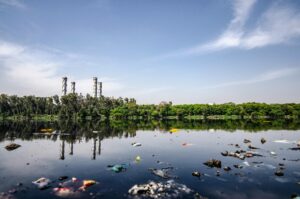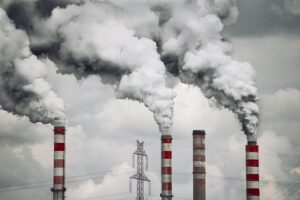Pollution in India
Pollution in India has become a serious problem that impact both its rivers and its cities. From heavily polluted rivers to toxic air quality, pollution is a growing concern in many parts of the country. This article discusses river pollution, air pollution, and highlights the most polluted cities and rivers in India, along with the causes and effects of these environmental issues.
River Pollution in India
River pollution in India is one of the most serious environmental problems. Many rivers, including some of the most sacred in the country, are being polluted by industrial waste, untreated sewage, and other contaminants. Rivers like the Ganges and the Yamuna are heavily polluted, making the water unsafe for drinking, bathing, and farming.

Causes of River Water Pollution in India:
• Industrial Waste:
Chemicals and wastes which are untreated are directly discharged into rivers.
• Sewage:
In many cities, untreated sewage is dumped into rivers, contaminating the water.
• Religious Practices:
Offerings, idols, and other materials thrown into rivers contribute to the pollution.
• Garbage Disposal:
People often dump plastic and other waste into the rivers, further polluting the water.
Most Polluted River in India:
The Yamuna River is one of the most polluted rivers in India. It flows through cities like Delhi, where untreated sewage, industrial waste, and plastic are dumped into it. Similarly, the Ganges River, despite its religious significance, faces severe pollution from industrial waste and human activities.
Air Pollution in India
Air pollution is another major environmental issue in India. Cities across the country, especially in the northern region, suffer from toxic air quality due to vehicle emissions, industrial pollution, and crop burning. Poor air quality can lead to serious health issues, including respiratory diseases, heart problems, and even cancer.

Causes of Air Pollution in Delhi:
• Vehicular Emissions:
Cars, buses, and trucks release harmful gases into the air.
• Industrial Emissions:
Factories contribute to air pollution by emitting smoke and chemicals.
• Crop Burning:
In neighboring states like Punjab, farmers burn crop residue, sending thick smoke into cities like Delhi.
• Construction Dust:
Large construction projects add to the air pollution by releasing dust and particulate matter.
Air Pollution Level in Delhi NCR Today:
Today, the air quality in Delhi NCR is often reported to be in the “hazardous” category, particularly in winter. This is caused by a combination of factors like crop burning, vehicular emissions, and weather conditions that trap pollutants in the air.
Most Polluted Cities in India
Several cities in India are known for their high levels of air and water pollution. These cities struggle with poor air quality, harmful chemicals in their water sources, and rapidly growing populations. Here are the top ten polluted cities in India, based on air quality:
1. Delhi
Delhi is often cited as the most polluted city in India due to a combination of vehicular emissions, industrial pollution, and crop burning in nearby states. The city’s air quality frequently reaches dangerous levels, especially during the winter months.
2. Ghaziabad
Located near Delhi, Ghaziabad suffers from similar pollution issues, particularly due to high traffic congestion, industrial emissions, and construction dust. It ranks as one of the most polluted cities in India.
3. Kanpur
Kanpur, an industrial city in Uttar Pradesh, faces high levels of air pollution from its leather industries, vehicle emissions, and crop burning.
4. Lucknow
Lucknow, the capital of Uttar Pradesh, has poor air quality due to increasing vehicle numbers, industrial pollutants, and construction dust.
5. Varanasi
Varanasi, known for its cultural and religious importance, also suffers from severe pollution. The Ganges River is heavily polluted, and industrial emissions and the burning of offerings contribute to the air pollution.
6. Faridabad
Faridabad, located near Delhi, has high pollution levels from nearby industries, vehicular emissions, and construction activities. The air quality is “very poor”.
7. Patna
Patna, the capital of Bihar, faces severe pollution due to increasing traffic emissions, industrial waste, and crop burning in nearby areas.
8. Jaipur
Jaipur, the capital of Rajasthan, experiences poor air quality from vehicular emissions, construction dust, and burning of crop stubble in surrounding agricultural regions.
9. Bhubaneswar
Bhubaneswar, the capital of Odisha, is relatively cleaner but still faces pollution from vehicular emissions, industrial activities, and construction dust.
10. Indore
Indore, the largest city in Madhya Pradesh, has seen increased pollution from rising vehicle numbers, industrial emissions, and inefficient waste management systems.
Least Polluted City in India
While many cities in India struggle with pollution, some cities have better air quality due to fewer vehicles, more green spaces, and less industrial activity. Some of the cities that have cleaner air are Shimla, Coimbatore and Mangalore and are considered the least polluted cities in India.
Pollution Challan in Delhi
In Delhi, the government has introduced a pollution challan system to fine individuals and companies that violate pollution norms. These fines are imposed on people who drive polluting vehicles or engage in practices that harm the environment, such as burning garbage or using non-compliant industrial equipment. The aim of these fines is to reduce pollution and encourage cleaner practices.
Why Delhi Pollution?
The pollution in Delhi is primarily caused by several factors, including heavy traffic, industrial emissions, crop burning, and poor waste management. During winter, weather conditions worsen the situation, trapping the pollutants in the air and making it difficult to breathe. Government efforts are ongoing to control pollution, but the problem remains severe.
Conclusion
Pollution is a serious issue in India, especially in its rivers and cities. From the polluted rivers like the Yamuna and Ganges, to cities with hazardous air quality like Delhi and Kanpur, the environmental challenges are vast. However, with the right policies, stricter enforcement of rules, and public awareness, India can work towards reducing pollution and creating a cleaner, healthier environment for its citizens.
Addressing river pollution, controlling air pollution, and ensuring better waste management systems are critical steps in the fight against pollution. By working together, both the government and the public can make a difference and help improve the quality of life for millions of people in India.
